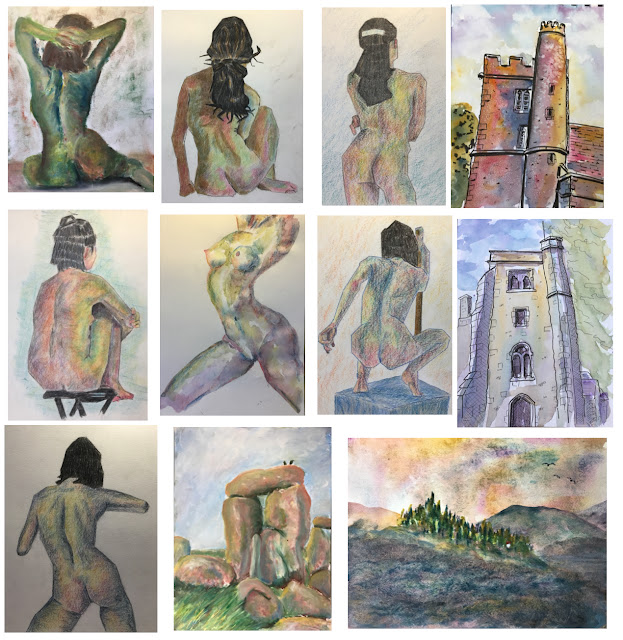There are twelve chapters in the book but I think they can be broken down into about 70 pages of introduction, 40 pages of tips and 50 pages of demonstrations. Let's talk about those three chunks.
What I'm calling the introduction takes up five chapters. There's some stuff in there on equipment. This includes an interesting comparison of the best coloured pencil brands. The most interesting bit for me is always the paper as there seems to not be a general consensus on what's best. I was glad to see that Helen had tips for what to use with coloured pencil on its own as well as what to use for coloured pencils with ink. There's also stuff on going outside looking for good source material and on composition. Then there's the mark making, both with the ink and the pencils. Burnishing gets a mention but Helen points out that burnishing is all about flattening the paper, not about mixing. For mixing without flattening, I need paper stumps and I've just ordered some of these. And then there are advanced techniques like embossing, sgraffito and lifting out. It's a decent introduction. I'm not sure it would work as a a complete introduction to a newbie though - while Helen tells us to be light with the pencils and that extra layers are better than extra pressure, I don't think this was hammered home hard enough for a complete beginner. Still, this probably isn't a beginners' book, so no harm done.
We then get to the middle of the book, the meat in the sandwich. Four chapters on how to do an ink and coloured pencil painting. There's stuff on putting down an initial drawing; not a chapter on how to draw but one on what ink and pencil marks to actually put down. And there are tips on drawing trees, water and sky and how to integrate the two different media together. There's an amazing chapter on how to do detailed drawings of foreground material like stones and grasses - Helen’s style is all about having detailed stuff like this in the foreground and less focus further back. And then there are the final checks on whether a painting hangs together and what to do if it doesn't. In all this section (and in the introductory chapters) the tips are tightly packed together, like in a Liz Chaderton book, and there seem to be more words than in normal art books - this took longer to read than other, breezier books.
And then we get to 50 pages of demonstrations. As usual, I found myself drifting away at times when reading these, although I did learn from them. A lot of the time, the demos served as illustrations of the lessons from the middle of the book. The biggest of those lessons, for me, was probably the way that Helen paints the foreground before the background and the darker areas before the lighter ones - in both cases the opposite to what I do in watercolour, so something I definitely needed to learn about coloured pencils. Somewhere at the start of the book, Helen makes the point that people will learn more by creating their own works than by copying other people, which had me punching the air in delight. And throughout the demonstrations (which are worded as demonstrations, not as recipes) she keeps emphasising this point, telling readers that they don't have to go out and buy all the exact colours in the demos but can use similar ones that they already have if they really need to copy the demos. And at the end of the demos, when Helen says she had to darken an area to get the balance right (or whatever) she says that's what she needed to do to her painting and that readers will have different problems that they'll have to sort out. It I expect that message will be lost to the recipe followers. After reading the Lisa Ann Watkins book, this all represented a refreshing change in style. While the demos weren't the most useful bit of the book to me, they were still inspiring and there was enough useful stuff in the first 110 pages that the demos were just a bonus. And there are always people complaining on Amazon about any art instruction books that don't include detailed recipes, so maybe this was all about keeping the peanut gallery happy.
This was, without a doubt, the best book I've read on coloured pencil so far. It teaches things the way I like to be taught. Lots of tips and examples of how Helen has used them, rather than a set of instructions on how to exactly replicate her art. It's close to being a good introduction to coloured pencils but not quite there. I do think, though, that it's a great introduction to coloured pencil landscapes, even for someone not intending to supplement the coloured pencil with ink, although it helps if the reader's interested in these detailed foregrounds.
I've not only learned a lot from this book but am feeling enthused and energised at starting on some coloured pencil landscapes over the weekend. And you know what that means? Five palettes.
🎨🎨🎨🎨🎨































